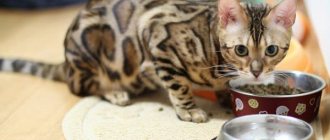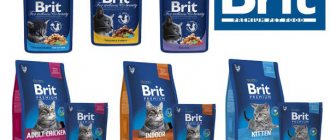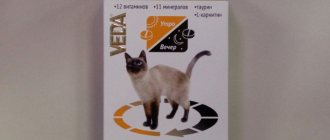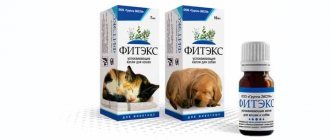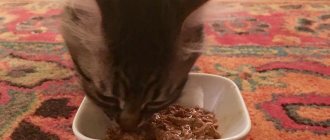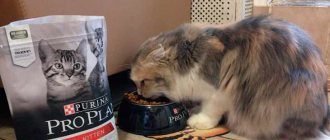The essence of sterilization
Before such an operation, examination and preparation are carried out. The latter includes a starvation diet and treatment with anthelmintic drugs. You need to stop feeding your cat ten to twelve hours before the operation, otherwise the animal may vomit during the operation. For a pet, such a restriction will not be too difficult. But a cat needs to drink, on the contrary, more.
This operation is simple and is generally performed under mild anesthesia. The fur on the area of the cat's body in the area of the uterus is shaved off, then a small incision is made there (no more than four centimeters). After this, the surgeon very carefully retracts and cuts the fallopian tubes and removes the ovaries.
An alternative to sterilization may be pills and injections, but this is only a temporary solution. In addition, many owners may be concerned about the effect of “chemistry” on the pet’s body.
Owners often worry about the health of their pets after sterilization, but, according to information from many sources, this procedure has a positive effect not only on the behavior of cats, but also on their life expectancy.
"Hills"
In total, there are five main reasons why you should give preference to this product:
- It contains carnitine. It has a positive effect on kidney function and is an excellent preventive measure for diseases of the genitourinary system.
- There are antioxidants that allow the animal to be in good shape until old age.
- In the composition you can see the inscriptions “macroelements” and “microelements”. They are responsible for good feed absorption.
- Vitamin E is a constant support for the immune system.
- Vitamins A and B are responsible for the external qualities of the pet. His coat, nails and teeth will always be in good condition.
Hills food for sterilized cats is not just a food product, but a universal formula for beauty and health.
Features of feeding a cat after sterilization
The cat needs to wear a special blanket for a week after surgery.
The question of what to feed a sterilized cat is important and very logical. Each intervention in the body is accompanied by a recovery period. In addition, after the sterilization procedure, changes in the body affect processes such as metabolism and urination. Their violation can lead to urolithiasis and obesity. You also need to be careful with your diet in the first days after surgery. Solid food is contraindicated for cats during this period. To avoid suture dehiscence, your cat's stool should be liquid. In addition, food should be warmed to room temperature and the cat should have constant access to water.
What not to feed sterilized cats
The diet of a sterilized cat should be tailored to its physiological changes. There are a number of products that should be completely excluded from it:
- Fresh fish. It is a source of phosphorus, which in certain cases provokes the development of urolithiasis.
- Semolina. It is a source of large amounts of carbohydrates, as a result of which sterilized animals quickly gain fat.
- Fatty meats. Pork is especially harmful to cats.
- Potatoes and legumes. They contain virtually no substances beneficial to cats. But they can very easily provoke the development of diarrhea or diarrhea.
Veterinarians also advise not to feed them with regular ready-made food. For them, you should choose special ones designed for sterilized animals.
Causes of increased appetite
After surgery, cats need a diet. You can check with your veterinarian for the most beneficial diet for your pet.
In addition to the described consequences of sterilization, there is another one, which not all owners report - this is increased appetite. Previously, cats had developed two instincts: reproduction and saturation. After sterilization, the need to find a partner and raise offspring disappears, and the cat devotes all its energy to the remaining instinct. Cats often cannot restrain themselves in terms of food restriction, and will eat all the food, no matter how much there is in the bowl. And therefore, it is correct to feed a sterilized cat, limiting its diet (or rather, do not fill the bowl as soon as it is empty), otherwise there is a high risk that your cat will become obese, and this is fraught with additional health problems.
Psychology of a sterilized cat
Sterilization for a cat is a strong hormonal and psychological stress. That is why after it is carried out, some pets change beyond recognition. After physiological changes have occurred, a cat’s taste preferences may even change greatly.
Most often, sterilized animals have a significantly increased appetite, they sleep more, play less and have almost no interest in the street. This is explained by the low level of estrogen, which was produced by the ovaries before the operation. And also the absence of stress caused by sexual hunting. If the cat previously had free access to the street and actively hunted, then after the operation it may become completely uninteresting to her, and she will prefer to spend most of her time on her favorite sofa or chair.
Food and drink in the first days after surgery
Immediately after the cat recovers from anesthesia (unfortunately, this process is often difficult), you need to give it water through a syringe. You need to wait a little with feeding. Portions in the first days should not be too large (a third of the usual dose). The food should be low-fat and easily digestible. The following diets are suitable:
- Low-fat cream;
- Grated cottage cheese;
- Curdled milk;
- Milk;
- Baby formula (sugar free);
- Natural yogurt;
- Egg (boiled and grated);
- Canned food (intended for cats that have recovered from illness or surgery, usually labeled).
When feeding your cat, do not insert the syringe too deeply - you may harm your pet.
You can offer the cat to drink on its own three to four hours after the operation, but to eat it no sooner than after 24 hours. There is no need to force feed - if the cat eats a few hours later, it’s okay. But refusing food and water for more than two days is a reason to consult a doctor.
On the third day, you can begin to gradually increase the weight of the portion, but you should stop at one hundred twenty to one hundred and thirty grams, due to the cat’s tendency to obesity after sterilization, described above.
Useful tips and tricks for owners
To keep your pet healthy, follow these guidelines:
- Always leave fresh water for your pet. It is recommended to wash bowls regularly to prevent bacterial colonies from developing there.
- Keep an eye on your cat's body type. Normally, your pet should not have protruding ribs. This indicates exhaustion. At the same time, the cat, when viewed from above, should not resemble a barrel. A similar thing occurs with obesity. In a normally well-fed animal, the ribs can be felt, but with little effort.
- Get your urine tested every 3-6 months. Rinse the tray thoroughly or get a separate one. As soon as your pet goes to the toilet, collect a portion of urine and take it to the clinic. The results will help to detect the onset of urolithiasis in time. In the early stages it is easier to deal with it.
- Check the composition of the food before purchasing. The meat components should be placed first. Make sure that the total amount of grains does not exceed the proportion of ingredients of animal origin. Keep in mind that raw meat consists primarily of water, while grains contain less liquid. Many manufacturers are trying to make the composition more attractive by dividing the grains into several positions. The list should not contain dubious names; specificity is encouraged.
- Do not purchase feed by weight. The bags sit open for a long time, so the granules in them can deteriorate ahead of schedule. Oxidation occurs as a result of contact with air and sunlight. Oils become rancid and bacteria actively multiply. In the best case, the pet will refuse such food, in the worst case, it will be poisoned or contract an infection or helminths.
- Transition to a new diet gradually. Immediately after surgery, it is better to feed your pet what he is used to. Switching to a different diet during this period can increase stress. Later, the feed should be replaced over a period of 1-2 weeks, gradually increasing the proportion of new pellets. It makes sense to gradually improve the quality of food if you previously gave your cat economy class food. First you need to switch the animal to premium products, then offer elite brands.
It is advisable to control how much liquid your cat drinks. On average, an animal should consume 30 ml of water per 1 kg of weight. If your pet doesn't drink much, try diluting the food pellets with water. If your pet refuses such food, it is wiser to switch him to natural products.
Diet preparation
Taking into account the fact that after sterilization the cat will begin to eat more and move less, the diet needs to be adjusted specifically to this lifestyle. In order to be sure that you are feeding correctly, it is advisable to find out the weight of the cat before sterilization and weigh it periodically.
A proper diet is the key to ensuring that your cat does not suffer from obesity or food shortages.
When organizing meals, do not mix natural food and purchased food, this can lead to digestive problems. If your cat's weight fluctuates up or down, adjust the amount of food your cat eats. Also, spend a lot of time on water: in summer you need to change it three to four times a day, in winter - from one to two times.
Natural food
An important product in feeding is meat. A lack of taurine, which it contains, can lead to impaired cat vision and decreased immunity. You can include turkey, chicken in the diet, and occasionally you can give beef, boiled heart, liver, poultry stomachs or sea fish (in no case river fish - it contains small bones). If the meat is purchased, it is better to freeze it for a period of ten to fourteen days before eating (unfrozen meat and fish can cause helminthiasis, and fresh meat can cause protein intoxication).
Much attention should be paid to the quality of meat, especially if it is purchased.
You can also prepare canned meat. To do this, you need to freeze chicken wings, necks, pork cartilage and ears for four days. Then boil the products and pass through a meat grinder. Add vitamin B12 to the resulting minced meat. The food can be packaged and frozen or rolled up.
You can make the food yourself - so at least you will be sure of its composition
It would also be a good idea to accustom your cat to meat broths, since they do not drink water very willingly, and they simply need to replenish their fluid supply.
The broth helps replenish the necessary fluid supply in the cat’s body.
Other products that are useful for sterilized cats include cottage cheese, kefir, yogurt (without sugar) and porridge (buckwheat, rice, wheat or barley; barley porridge (leads to constipation) and semolina should be excluded).
Contrary to popular belief, large amounts of milk are not good for your cat.
Vegetables that contain fiber, which plays an important role in digestion, are also good options. Fruits are acceptable in small quantities (seasonal apples are among the healthiest). For periods when the cat wants to eat grass, you can grow wheat or oats. You can also buy ready-made greens at a pet store. However, in any case, after sterilization, the pet needs additional vitamins and microelements that are not contained in natural products suitable for cats. For example, bone meal is added to food to strengthen bones, and sulfur is added to food for good wool. Veterinarians themselves can also recommend certain vitamin complexes.
Industrial feed
You can also feed a sterilized cat regular food. The main condition: you need to choose it correctly. Do not give preference to cheap foods, as they are of lower quality than premium foods and contain large amounts of heavy minerals and salts, which, in turn, contribute to the development of kidney and liver diseases. You need to purchase food with the appropriate mark (their protein absorption rate is more than eighty percent). They are intended for sterilized cats and female cats, contain a minimum amount of salts, calories and fats, but phosphorus, potassium and magnesium - in moderate quantities. Most often, veterinarians recommend using ProPlan, Royal Canin, Hill's and Choice.
Pay attention to the composition of the food: high-quality food will have meat in the first place among the list of ingredients
By the way, if an expensive food is not marked “For sterilized/neutered cats,” it can still be used for feeding.
Super and premium food is best suited for sterilized cats
The quality of the feed can be determined by its description. The ingredients in a good food are arranged in descending order, with meat first. Also, such food should not contain dyes or flavoring additives. What should be listed there is L-carnitine and L-lysine (the first speeds up metabolism and burns fat, the second maintains muscle mass). Between canned food and dry food, it is better to choose the former, since it contains an additional portion of liquid.
Features of mixed nutrition
Dry and wet food must be the same brand
Alternating dry and wet food, or food and natural food can do a disservice to your pet and “settle” the stomach, since it simply does not have time to readjust itself during the assimilation of this or that food. Alternation is acceptable in cases where you give your pet a different type of food in the form of treats and in small quantities. As for different brands, you need to stick to one of them when feeding. From different manufacturers, the composition of the food is at least slightly different, and this also does not benefit your pet’s body.
What not to feed
Many foods can be simply poisonous to your pet.
The restriction applies to dishes containing large amounts of magnesium and phosphorus. After sterilization, you also need to exclude certain types of fish (pollock and cod), sugar and sweets, legumes, smoked meats and sausages, garlic and onions, pork, oatmeal and semolina, potatoes, and raw eggs. In addition, cat dishes should not be salted.
It is advisable to resolve the issue of nutrition before the procedure.
The first day after sterilization should not be filled with large meals; it is better to give the cat plenty of fluids to remove anesthesia and anesthetics. Next, offer small portions of food, assessing the body’s further reaction to it. Usually 2 feedings are sufficient.
You need to pour or put in small portions. The main thing, especially when using dry food, is to fill the bowl with clean water, changing it every day at intervals of 1-2 (winter) and 3-4 times (summer season). It is important not to overfeed your pet; increased weight negatively affects the condition of the mucous membrane and coat, and contributes to the occurrence of urolithiasis. The work of the heart deteriorates, the vessels become inelastic and clogged.
When choosing to feed cats from natural products at home, you should consider important nuances:
- Keep your diet balanced; you must include a complex of vitamins and minerals. In nurseries or clinics, bone meal is used to strengthen the skeleton, and sulfur is used for wool quality.
- All food should be given slightly warm or at room temperature.
- Only freshly prepared food. The leftovers are not stored in a bowl; it is better to throw them away (chapping and rotting).
- Follow a dietary regime with a low-calorie diet and a full amount - so that the cat does not gain weight, but remains active and healthy. It is advisable to take professional advice from a veterinarian to calculate the sufficient volume; it is difficult to do such a calculation yourself. Sometimes the packages of ready-made coma contain recommendations regarding servings in grams - follow them.
- The nature of a predator requires meat, preference is given to turkey or chicken. Rarely (1-2 times a week) allow sea fish (river contains parasites and heavy metals) and beef.
A boiled chicken egg will also be useful; a raw one can “provide” your pet with salmonellosis. You need to pour or put in small portions
- The inclusion of fermented unsweetened and low-fat products (cottage cheese, kefir, fermented baked milk, yogurt) - adults do not need milk, it is even harmful.
- Use carbohydrates in your diet; buckwheat, rice, and wheat cereals are suitable. “My cat is a fan of barley porridge,” writes the owner of the Sphynx. At the same time, semolina is not recommended due to the small amount of useful elements in it and complex processing during the manufacturing process. Barley porridge contributes to constipation.
- Sometimes add by-products to the weekly menu - liver (remember that its properties are to accumulate heavy metals), hearts, stomachs. Be sure to boil before use. Do not give raw meat to your pets (worms and protein intoxication); freeze it or bring it in boiling water until half cooked, then feed the cat.
- Vegetable oil (any oil, not just olive oil), fish oil in capsules help improve the functioning of the excretory system, prevent constipation, and normalize metabolic processes. There is some fat in chicken skin, but its amount does not cover the minimum dose in the diet.
- Healthy and tasty treats for a sterilized cat are fruits; preference should be given to seasonal apples, peeled from seeds and skin.
Feeding regimen and norms
Measure the weight of the animal to know whether the diet and amount of food are chosen correctly
The daily nutritional intake of a sterilized cat depends on the weight of the pet (thirty to fifty grams of food per kilogram of weight). According to doctors' recommendations, a cat needs one hundred and forty to two hundred and fifty grams of food per day, of which seventy to one hundred and twenty grams should be meat, thirty to sixty should be lactic acid products, thirty five to fifty should be vegetables and ten to twenty should be cereals. Feeding should be done twice a day (you can’t feed at the first call, don’t give in to the cat’s pleading eyes). If you notice that you cannot feel your cat’s ribs (one of the first signs of obesity), you need to switch to fractional feeding: the number of meals is increased to four to five times, and the portions are reduced.
Where is Royal Canin made?
The main enterprises are located in France, one of the subsidiary plants is in the Moscow region (Russia). Russian biscuits and canned food from Royal Canin for sterilized cats are considered to be of lower quality, since the requirements for their production in the country are lower than in the European Union, so owners prefer to feed their pets with French canned food.
Royal Canin is the most popular brand on the market
For your information! The remaining enterprises are located in different countries, but their products are not imported to the Russian Federation. The products are manufactured by Brazilian, Argentine, Canadian, American, South African and British factories.
Place for eating
While eating, the cat should not be disturbed by anything or anyone - this will help avoid digestive problems.
It is also important to choose a suitable place for feeding your pet: quiet and calm enough so that no one disturbs it, in order to avoid absorbing food too quickly (in this case, there is a high probability that the cat will vomit the food). The place should also be clean, at a fairly large distance from the tray. You can use a special mat on which you will place the bowl. If there are many animals in the house, the bowls should be at a sufficient distance from each other. Well, if the pets don’t get along with each other, their feeding places need to be separated altogether. Feeding times should always be the same.
Proper nutrition for a sterilized animal
I need to give you more to drink
The basic principle in feeding a sterilized cat is what she ate before they decided to sterilize her:
- if the animal was fed with industrial feed, then nothing needs to be changed;
- Feeding homemade food to which the cat is accustomed should also be left at the same level.
If everything remains at the same level, then the question: how to feed a sterilized cat is inappropriate? Actually this is not true. There are certain restrictions on how to properly feed your pet due to the consequences of the operation.
After sterilization of a cat, you should be aware of a number of the following changes in its diet:
- Since most castrated (sterilized) dogs begin to gain weight immediately, they should be limited in food intake. The restriction should begin with reducing the portion of food and increasing the amount of water to drink. Further feeding is carried out in the same volume as before, but in smaller doses.
- The food must be given in such a way that it contains either no or minimal phosphorus and magnesium. That is, fish must be excluded - it contains these elements. This is done to avoid kidney and bladder stones.
- After sterilization, an animal may begin to drink less or stop drinking water altogether. In this case, you can add water to the food. Industrially produced food, such as canned food in packs or jars, contains a lot of liquid and this is quite enough for the normal functioning of the cat’s body.
- A sterilized animal needs to add vegetables to its diet. This, of course, should be done in such a way that your pet does not turn away from the imposed feeding.
- Do not mix industrial feed (canned food) and homemade food. If the morning feeding consisted of natural food, then in the evening you can give chicken or beef. Natural meat must be cooked.
How to understand that the food has been chosen correctly
The appearance and behavior of the pet will unmistakably make it clear that the diet has been chosen correctly.
You can determine whether you have chosen the right diet for your cat by its behavior. If she eats well and with pleasure, she has regular bowel movements (no constipation or stomach upsets are observed), her hair is shiny and does not fall out, and you see that she feels good - it means that you are doing everything right and the cat has enough food, water and vitamins It can be adjusted over time depending on your pet's reactions and changes in behavior.
Which products are dangerous?
Before you go into the kitchen to prepare food for your pet, there are several factors to consider. You should understand: foods you like may be harmful to cats.
Cats are prohibited:
- chocolate, products with cocoa beans - contain theobromine, toxic to animals;
- onions, garlic, grapes, raisins;
- tomatoes, eggplants;
- sugar, salt, soda, baking powder;
- sweets (sweets, cakes) cause diabetes and allergies;
- herbs, spices;
- alcohol;
- artificial sweeteners;
- tea, coffee, products, medications from a human pharmacy containing caffeine;
- dog food (dry, wet), because has a different composition:
- pork, lamb;
- bones, heads, tails, paws can cause intestinal obstruction and digestive tract injuries;
- semolina, millet, corn porridge - useless food;
- pasta, flour - cause obesity, constipation, colitis;
- leftover human food (fried, smoked, baked);
- sausages;
- raw eggs;
- veterinarians do not recommend feeding cats raw meat purchased in markets or stores - it often contains dangerous hormones and antibiotics;
- pickled vegetables, fruits;
- freshwater fish - risk of helminth infection;
- seafood;
- mushrooms - the cat’s body does not digest them, does not produce enzymes capable of breaking them down, the cat can even be poisoned by edible ones;
- nuts are not digestible and can cause a severe allergic reaction, including respiratory arrest.
Feeding your pet a natural menu requires a competent, attentive approach. You need to spend a lot of time, often a lot of financial resources, to provide the animal with a varied, balanced menu. A cat, just like us, cannot eat the same product all the time.
It is especially important to monitor the nutrition of animals that have recovered from illness, those who have undergone surgery, pregnant animals, young animals, and those suffering from chronic diseases. In such cases, it is better to listen to a veterinarian or feline health specialist to rule out dangerous products.
Sometimes even healthy foods can cause harm if you use them in excessive quantities.
Before you sit down at the table, you should feed the animal. A hungry cat is especially sensitive to the smells of human food, begins to intensively beg for food, then eats with increased appetite, which eventually causes obesity.
Be attentive to your pet’s behavior: an unsuitable product must be immediately eliminated and replaced with another. If your pet friend looks good, is cheerful, healthy, and playful, then the diet is correct. This means that food prepared with your own hands will give your pet good health, a long, happy life, and excellent health.
Products that are dangerous for cats
Avoid feeding your neutered cat food from your table. You may not know, but duck, goose, pork and lamb, due to their high fat content, are poorly absorbed by the animal’s body. By the way, you can give raw meat, but only after pre-freezing. But a steam room is a direct path to helminthic infestations and other unpleasant infections. You should not feed your purr chicken bones, because they can get stuck in the teeth or throat.
Some cat breeds are known for their strange eating habits, so they often strive to enjoy sweets from the hands of their owners. But sugar is very harmful for them because it weakens the immune system and disrupts metabolism, causing obesity. Prepare all the food you are going to feed your mustachioed pet without salt and other spices - they are not digested, but simply settle in the body, retaining liquid. And this is generally unacceptable for cats after sterilization.
A variety of smoked meats, sausages and fried meats are completely contraindicated for the entire meowing family. First of all, the digestive system of animals suffers from them. Purrs have lethargy, dull fur, and a sickly appearance. All this indicates a violation of metabolic processes in the body. Potatoes and legumes, with the exception of asparagus, can cause bloating and indigestion because they are foods that cats cannot digest.
If your pet suddenly develops a health disorder, under no circumstances treat it with drugs for humans at your own peril and risk. It is better to immediately seek help from a veterinarian and purchase special medications. The same applies to vitamin-mineral complexes, which cats simply need after sterilization. They should also be used only after consultation with a specialist.
Clean eyes, thick hair with a characteristic healthy shine, teeth without plaque - all this indicates the cat’s good health and a properly selected diet. It is not difficult to determine the presence or absence of excess weight. Just run your hands along the back and sides of the pet; if the ribs and spine can be easily felt, then there is no threat of obesity. But you can keep a cat in good physical shape after sterilization not only by regulating nutrition.
Buy different toys so that the animal can have fun both with you and alone, and not just alternate between naps and approaches to the bowl. Remember that the health and happy appearance of any domestic cat depends entirely on the love of its owners. Therefore, always find time to communicate with your pet, and then food will not become the only way for her to enjoy life after sterilization.
Foods that need to be excluded from the diet
Sterilized pets need a special selection of their diet, as many changes occur in the body. First of all, a slow metabolism occurs. Energy requirements are reduced and appetite increases significantly, so it is necessary to carefully monitor her diet in order to avoid obesity. After sterilization, many pets experience a decrease in the frequency of urination, which exposes them to urolithiasis.
© shutterstock
That is why, never feed your cat such foods as:
- Fish, since phosphorus has a negative effect on the body
- Oatmeal contains large amounts of unwanted magnesium
- Semolina porridge is a source of carbohydrates
- Any dairy products whose fat content is above 10%, this can be sour cream or cream
- You should definitely forget about smoked, fried or pickled foods.
- Legumes and potatoes are high in calories and can cause diarrhea.
Never feed fresh meat to your cat, as this can cause not only the appearance of worms, but also protein intoxication. Do not try to use medications from your medicine cabinet to treat your pet, even if indigestion or bloating occurs.



